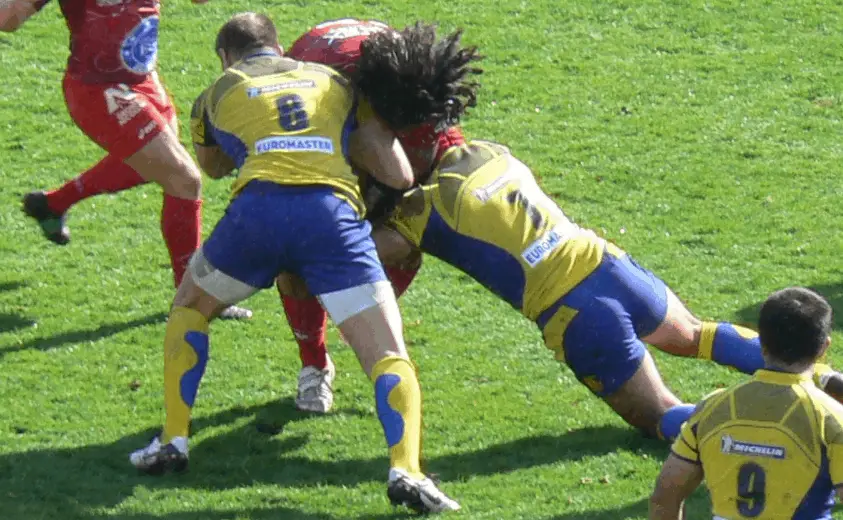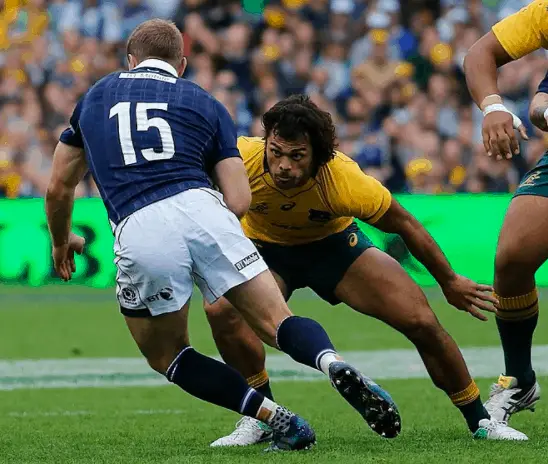If you want to improve your rugby tackling, you have got to practice right? But what if you are stuck at home with no one to practice your tackling with Well, with enough enthusiasm you can absolutely improve your rugby tackling skills at home. Here’s how…
To improve your rugby tackling at home you can work on three things: analysis and modeling of leading players, visualisation techniques, and fitness and tackling drills.
Let’s unpackage some of those things. All professional teams have video analysts so I’ll show you how to do the same to improve your tackling. Visualisation is now an accepted part of top level sport and I’ll share with you what worked for Jonny Wilkinson and I’ll also share the tackling routine of one of England’s greatest openside flanker’s that you can do at home. Sounds good? Okay, let’s go!
How To Improve Your Rugby Tackling At Home?
Step 1: Pick a role model and analyse
Rugby tackling practice is not all about throwing yourself about in the mud, that comes later. You first need to know exactly what it is you are trying to achieve. Have you even considered what type tackle you want to improve at?
Just wanting to improve your tackling is not a specific enough goal. There are at least 11 different types of tackle, including: front on crash tackles, front on tackles with roll to the side, front on high to low, front on high and hold to name just a few.
So, my first recommendation is to select an international player you enjoy watching who plays the same position as you and then analyse their tackling technique. Don’t just passively watch the game they are playing in. Make a real effort to follow them as closely as possible on the pitch.
Try to identify things such as:
- Where they stand in the defensive line?
- What types of tackles are they mostly making?
- What is their foot positioning like before tackles?
- What part of their body are they hitting their opponent with?
- What height are they hitting them at?
- What are the features of their tackle technique? Consider: body height, angle into tackle, knee drive, head position, arm position in relation to ball, actions on completing tackle.
Make detailed notes on these aspects of their play and use them as a model to try and emulate. 80% of learning is done through copying so pick a role model you want to be like analyse their technique and copy them.
Reduce the notes that you have made into 5-6 clear bullet points, stick them up somewhere you will see often, or at the least on your phone so that you can refer to them before training. Incidentally, if you haven’t got a preferred position yet then check out our helpful guide to choosing your position here.

Step 2: Visualize successful tackling
Now that you are clear on the types of tackles that you are trying to improve at, and the technique you should be using, it is now time to jump into visualization.
Now, I know visualization might seem a little airy fairy or something that is just for elite athletes, but I’ll let you in on a secret. Visualization is a powerful tool that any player can use at any level of the game.
I first took visualization seriously after reading a book way back in 2001 called ‘Think and Play Winning Rugby’. To say it transformed my game would be an understatement.
The book, co authored by Grant Fox, the great New Zealand goal kicker of the time, covered in detail a variety of mental aspects of the game, such as: goal setting, affirmations, relaxation techniques, expectation and also a prominent chapter on creative visualization.
Long story short, I went from being bench player to being the clubs leading try scorer and player of the season in the space of just one season, and the only difference being the use of visualization.
If you are still not convinced though, check out this study here which proves the correlation between creative visualization, or mental imagery as it is sometimes referred and improved sports performance.
Jonny Wilkinson describes visualization it in his autobiography as:
“A sort of clarified daydream with snippets of the atmosphere from past matches included to enhance the sense of reality. It lasts about twenty minutes and by the end of it I feel I know what is coming. The game will throw up many different scenarios but I am as prepared in my own head for them as I can be.”
Jonny Wilkinson
You see yourself picking good lines, making big hits with the correct technique, making difficult passes, executing all the skills correctly and see yourself winning. It seems to have an incredibly galvanizing impact on your performance and is something you can do at home to improve your tackling.
I would spend 10-20 minutes per day visualising your tackling and really seeing and feeling yourself making a variety of different tackles and executing them to perfection. Then, when it comes to game time your body will know exactly what is required from it to succeed and you will have a greater chance of doing just that!
You might find the following guide useful: The Rugby Hand Off: Tips, Techniques And Rules
How To Use Creative Visualization For Rugby
1.Find a quiet place. Sit in a comfortable position, close your eyes and focus on your breathing. Take long slow breathers in and out.
2. Visualize the setting. Picture yourself walking out on to the picture in first person. What is the weather like? How long is the grass? What voices can you hear in the crowd? Feel the sweat dripping off you forehead and so on.
3. Use all your senses. Visualize your game or aspects of your game in detail. Visualize your defense. Visualize standing in the correct place, with the correct body position, feel your body going through the correct technique and imagine the impact as you tackle a payer to the ground, see how dominant you are in the tackle. Go through the different types of tackles.
Next, switch to attack, visualize you busting through the gain line in the loose. See yourself running your set piece moves with the perfect timing making big meters every time. Visualize yourself offloading, supporting others and scoring tries under the posts. Feel the feelings and really live those moments in your minds eye. If at any point you picture the wrong outcome, rewind the mental video and play it again correctly.
4. Practice frequently. You will develop your own version of this routine over time and when you see the results n how you feel about your game before matches and how much better the game unfolds for you, you will want to keep doing it which is the key.
Of course, you can do this with other aspects of your game that you wish to improve on at the same time too. I have written some more useful tips for improving your game here.

Step 3: Complete tackling drills
Now, its time to actually do some tackling. This might be difficult on your own at home but here is what you can do. You are unlikely to have a large free standing tackle bag at home so you are going to have to improvise.
As ridiculous as it sounds, I used to use an old large family tent that was kept in a large cardboard box and contained those old style metal tent poles that used to form the frame of a large family tent. The cardboard kept it soft enough to tackle but the metal poles inside kept it heavy enough to take a full tackle and to stand upright unaided.
So, you are going to have to be creative here. What have you got laying around the house? Is there anything that could be wrapped in an old duvet for you to use. Any very large old kit bags that could be rammed full of old clothes or rugby jerseys to create a tackle bag?
“Big guys coming, get low and use shoulder. Just need to be confident.”
Richie mccaw
An easy home tackling drill:
- Mark out two points on the ground ten metres apart. Stand a large tackle pad in the middle.
- Run up and explode into the tackle bag tackling it to the ground.
- Stand the bag up again, then sprint through to the far line.
- With no break, turn around and explode off the line again and smash the pad again.
- Complete a set of ten tackles for one set.
Rest for 2-3 minutes between sets and build up to 5 sets. You might want to start with just 3 sets and drop the number of repetitions each set.
A tough full work outdoing this is to do 10 sets but each set reduce the number of reps by one, so it goes, 10 tackles, rest 3 minutes, 9 tackles, rest 3 minutes, 8 tackles, rest 3 minutes all the way down to a final single tackle.
This session will leave you shattered, build your tackling fitness and endurance to bounce back up off the floor. It can take you to a dark place but if you do this when you go into games you will know that you have.
Side note: The tackler is the most commonly injured person in the game, why not check out: What Does Rugby Insurance Cover?
Step 4: Conditioning exercises for tackling
Building explosive power along with improving timing and technique is imperative for improving your ability to be able to tackle and make a difference noth at the beginning and end of a game. A personal favourite of mine was to work on explosive power by towing an old car tyre.
I would use my weight training belt and fasten a rope to it at the back and tie the other end around a tyre. I would then do 30 metre all out sprints with walk back recoveries. I did 30 metre reps x 10 then 20 metre sprints x 10, and finally 10 metre sprints x 5.
Of course, if you have a set of free weights at home then you can work on explosive lifts, such as deadlifts, power cleans, and squats to help improve your power in the tackle as well.
Step 5: Feedback, rinse and repeat
If you are working on all of the above that is great but how do you know if you are improving, how do you know if what you are doing is working?
Well, the only real test is on the pitch. Get yourself videod for a full game and watch it back with a coach/senior player. Be honest, what are you doing well and what do you need to work on still?
Once you have worked out any areas you need to work on, foot positioning for tackling for example, then you need to either design or dig out some sort of drill to help improve this aspect of your game.
This is a critical final step and it may seem like a lot of effort to go to but this is where the real progress can be made at home – work on the areas that you know you need to improve on.
Of course, you need to keep doing the things that are working for you but by pushing yourself to improve, learn and grow your overall performance will increase as a result and you will enjoy the game far more regardless of what level you play at. Good luck. You might also like to read our awesome guide to the basic rules of rugby here.
Photo Credits:
Front cover: The 2017 mid-year rugby union international, 17 June 2017, Australia vs Scotland at Allianz Stadium, Sydney. www.davidmolloyphotography.com from Sydney, Australia, CC BY 2.0, via Wikimedia Commons
Photo 2: Montpellier v Clermont Auvergne 2010 Zegreg63, CC BY-SA 3.0, via Wikimedia Commons
Photo 3: The 2017 mid-year rugby union international, 17 June 2017, Australia vs Scotland at Allianz Stadium, Sydney www.davidmolloyphotography.com from Sydney, Australia, CC BY 2.0, via Wikimedia Commons
